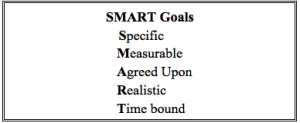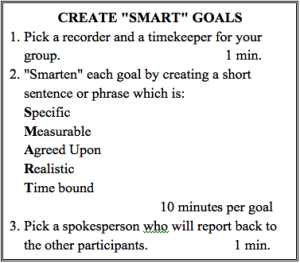“I think the goals we set are clear and agreed upon during our meetings, but even hours later there seems to be little agreement about exactly what we agreed to. How can we avoid this problem?”
#2: SMART Goals
What are SMART Goals?
The SMART Goals technique helps you obtain clear agreement from your meeting group about exactly what is meant by any particular goal. This technique is also excellent for improving the likelihood that a specific goal will be implemented to the satisfaction of everyone who is involved.
The SMART in SMART Goals is an acronym for Specific, Measurable, Agreed Upon, Realistic, and Time bound. The SMART Goals technique requires that these five elements be included in the communication of every goal so that there will be understanding, agreement and action on every level of the organization.
Often times, broad organizational goals are set on a corporate level, and then need to be translated into more detailed, operational goals as they cascade throughout the organization. These goals communicate what the priorities of an organization, group, or individual should be. SMART Goals make this process more manageable and trackable. Following is a simple example of how SMART Goals work and might cascade through an organization. The original corporate goal could be simple: “Increase profits.” The SMART Goal for the organization as a whole might then be written as: “Increase our current profit margin of 5% to 15% by December 31, 2016.” As a result of this corporate goal, a SMART Goal for a support service department of the organization might then be defined as: “Decrease departmental operating costs by 10% by December 31, 2016.” Perhaps after the support service department has done some investigation on how to reach their goal, a specific area within that department might have a subsequent SMART Goal: “Decrease the cost of producing and distributing marketing materials by 25% by October 1, 2016.” And an individual within the department which produces and distributes marketing material may have a individual SMART Goal: “Create and lead a work team to identify methods to decrease the costs of producing and distributing marketing materials by 25% by October 1, 2016.”
But to get the most from your SMART Goals, you must proactively monitor the progress and results of each specific action plan designed to meet your originally defined goal.
There are serious consequences if this monitoring step doesn’t occur. First, without effective follow-up, the specific actions may simply be forgotten. Second, a lack of sincere follow-up indicates a lack of seriousness about goal achievement. This speaks volumes to the people who work in the organization. It is unlikely that employees will follow through when actions are not tracked or rewarded.
When to Use SMART Goals
- When you want to be sure that your goals are clear and easily tracked
- When goals must cascade down throughout an organization
- When performance of a group or individual needs to be measured and evaluated
How to Use SMART Goals
- After goals have been brainstormed and agreed upon, introduce the SMART Goals technique to your group. In addition to explaining what makes a goal SMART, lead a brief discussion on the value of “smartening” goals. You might say, for example, “In order to make sure that we all agree exactly what each of these goals mean, what our measurable targets are and in what time frames, let’s take the time to make these goals SMART Goals. SMART is an acronym that stands for Specific, Measurable, Agreed upon, Realistic and Time bound.” Write the acronym and its meanings on a chart like the one below.
Then you might say, “What do you see as the advantages of us having SMART Goals?”
- Lead a discussion in which your meeting group creates a SMART Goal for each of the goals originally agreed upon.
OPTION: When you have several goals and a large group, break the group into smaller groups, assign one or two goals to each small group, and ask them to report back their drafted SMART Goals to the larger group for approval. This saves time and increases the participation of everyone in the group. Use a chart similar to the one below to support you.
- Plan specific actions to reach your goals. Depending on the breadth of the goal, either develop action plans within your group or determine how to cascade the goal/s throughout the organization. Plan how to communicate your goals. Determine how best to monitor progress for each SMART Goal.
NOTE: As implementation begins, actions may need to be fine-tuned and prioritized to ensure goals are achieved.
NOTE: Instead of waiting to check results after the goal deadline, it’s better to have logical checkpoints, especially for large and long term SMART Goals.
In Summary:
SMART Goals help you obtain clear agreement from your meeting group about exactly what is meant by any particular goal. SMART Goals are designed to be Specific, Measurable, Agreed Upon, Realistic, and Time bound, and act as a vehicle to establish organizational, group, and individual priorities.
- After goals have been brainstormed and agreed upon, introduce the SMART Goals technique.
- Ask your group to create a SMART Goal sentence or phrase for each of the goals originally agreed upon.
- Plan specific actions to reach your goals.
———————-
NOTE:
If you would like to receive e-mail notification when I post additional techniques, please sign up through this link. http://eepurl.com/KILan You may unsubscribe at any time.
You will find my book Mission Critical Meetings: 81 Practical Facilitation Techniques on Amazon. Your feedback and reviews are most welcome.

